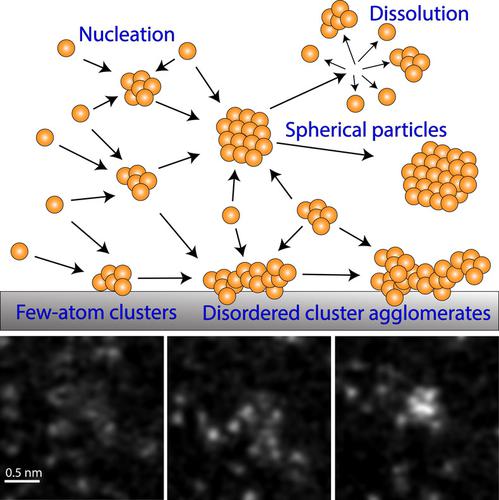当前位置:
X-MOL 学术
›
ChemNanoMat
›
论文详情
Our official English website, www.x-mol.net, welcomes your
feedback! (Note: you will need to create a separate account there.)
Structure Matters – Direct In‐situ Observation of Cluster Nucleation at Atomic Scale in a Liquid Phase
ChemNanoMat ( IF 2.6 ) Pub Date : 2020-11-06 , DOI: 10.1002/cnma.202000503 Trond R. Henninen 1 , Debora Keller 1 , Rolf Erni 1
ChemNanoMat ( IF 2.6 ) Pub Date : 2020-11-06 , DOI: 10.1002/cnma.202000503 Trond R. Henninen 1 , Debora Keller 1 , Rolf Erni 1
Affiliation

|
The formation of almost all solid crystalline materials starts with a nucleation reaction, where a handful of atoms come together to form the initial crystal seed, which then grows to a larger crystal. Thus, understanding and controlling nucleation is essential for the synthesis and manufacturing of most material systems, especially nanomaterials. Despite this, little is known from direct experimental observations about the initial steps of nucleation, the formation of sub‐nanometer sized clusters. Here, we directly study the atomic nucleation reactions of such sub‐nm clusters of Pt in‐situ in a liquid phase. We do this by inducing nucleation in suspended nanofilms and supported nanodroplets of an ionic liquid (1‐butyl‐3‐methyl imidazolium chloride, 5–50 nm thickness), which is observed at atomic resolution by scanning transmission electron microscopy. We can observe Pt atoms to nucleate into few‐atom clusters, which coalesce and grow into cluster agglomerates or nanoparticles, or redissolve. When comparing nucleation in nanofilms and carbon‐supported nanodroplets, nucleation is rarely observed in nanofilms, while easily observable at high nucleation rate in nanodroplets. This is due to the presence of the pre‐existing liquid‐solid interface, resulting in heterogeneous nucleation in the nanodroplets while there is only homogeneous nucleation in the nanofilms. Ultimately, our results show that the nucleation pathways of nanoparticles are not just determined by the local chemical environment, but are also influenced by size and structure of the initially formed clusters.
中文翻译:

结构问题–液相中原子级团簇形核的直接原位观察
几乎所有固态晶体材料的形成都始于成核反应,其中少数原子聚在一起形成初始的晶种,然后生长成更大的晶体。因此,理解和控制成核对于大多数材料系统,尤其是纳米材料的合成和制造至关重要。尽管如此,从直接的实验观察中,关于成核的初始步骤,亚纳米级团簇的形成知之甚少。在这里,我们直接研究了液相中Pt的亚纳米簇的原子成核反应。我们通过在离子液体(1-丁基-3-甲基咪唑鎓氯化物,厚度为5-50 nm)的悬浮纳米膜和支持的纳米液滴中诱导形核,通过扫描透射电子显微镜在原子分辨率下观察到。我们可以观察到Pt原子成核为几个原子团簇,这些团簇聚结并成长为团簇团聚体或纳米颗粒,或重新溶解。当比较纳米膜和碳载纳米滴中的成核时,很少在纳米膜中观察到成核,而在纳米滴中以高成核率很容易观察到成核。这是由于预先存在的液固界面,导致纳米液滴中的异相成核,而纳米膜中只有均匀的成核。最终,我们的结果表明,纳米颗粒的成核途径不仅由局部化学环境决定,而且还受到最初形成的团簇的大小和结构的影响。我们可以观察到Pt原子成核为几个原子团簇,这些团簇聚结并成长为团簇团聚体或纳米颗粒,或重新溶解。当比较纳米膜和碳载纳米滴中的成核时,很少在纳米膜中观察到成核,而在纳米滴中以高成核率很容易观察到成核。这是由于预先存在的液固界面,导致纳米液滴中的异相成核,而纳米膜中只有均匀的成核。最终,我们的结果表明,纳米颗粒的成核途径不仅由局部化学环境决定,而且还受到最初形成的团簇的大小和结构的影响。我们可以观察到Pt原子成核为几个原子团簇,这些团簇聚结并成长为团簇团聚体或纳米颗粒,或重新溶解。当比较纳米膜和碳载纳米滴中的成核时,很少在纳米膜中观察到成核,而在纳米滴中以高成核率很容易观察到成核。这是由于预先存在的液固界面,导致纳米液滴中的异相成核,而纳米膜中只有均匀的成核。最终,我们的结果表明,纳米颗粒的成核途径不仅由局部化学环境决定,而且还受到最初形成的团簇的大小和结构的影响。当比较纳米膜和碳载纳米滴中的成核时,很少在纳米膜中观察到成核,而在纳米滴中以高成核率很容易观察到成核。这是由于预先存在的液固界面,导致纳米液滴中的异相成核,而纳米膜中只有均匀的成核。最终,我们的结果表明,纳米颗粒的成核途径不仅由局部化学环境决定,而且还受到最初形成的团簇的大小和结构的影响。当比较纳米膜和碳载纳米滴中的成核时,很少在纳米膜中观察到成核,而在纳米滴中以高成核率很容易观察到成核。这是由于预先存在的液固界面,导致纳米液滴中的异相成核,而纳米膜中只有均匀的成核。最终,我们的结果表明,纳米颗粒的成核途径不仅由局部化学环境决定,而且还受到最初形成的团簇的大小和结构的影响。导致纳米液滴中的异质成核,而纳米膜中仅存在均匀的成核。最终,我们的结果表明,纳米颗粒的成核途径不仅由局部化学环境决定,而且还受到最初形成的团簇的大小和结构的影响。导致纳米液滴中的异质成核,而纳米膜中仅存在均匀的成核。最终,我们的结果表明,纳米颗粒的成核途径不仅取决于局部化学环境,而且还受最初形成的团簇的大小和结构的影响。
更新日期:2020-11-06
中文翻译:

结构问题–液相中原子级团簇形核的直接原位观察
几乎所有固态晶体材料的形成都始于成核反应,其中少数原子聚在一起形成初始的晶种,然后生长成更大的晶体。因此,理解和控制成核对于大多数材料系统,尤其是纳米材料的合成和制造至关重要。尽管如此,从直接的实验观察中,关于成核的初始步骤,亚纳米级团簇的形成知之甚少。在这里,我们直接研究了液相中Pt的亚纳米簇的原子成核反应。我们通过在离子液体(1-丁基-3-甲基咪唑鎓氯化物,厚度为5-50 nm)的悬浮纳米膜和支持的纳米液滴中诱导形核,通过扫描透射电子显微镜在原子分辨率下观察到。我们可以观察到Pt原子成核为几个原子团簇,这些团簇聚结并成长为团簇团聚体或纳米颗粒,或重新溶解。当比较纳米膜和碳载纳米滴中的成核时,很少在纳米膜中观察到成核,而在纳米滴中以高成核率很容易观察到成核。这是由于预先存在的液固界面,导致纳米液滴中的异相成核,而纳米膜中只有均匀的成核。最终,我们的结果表明,纳米颗粒的成核途径不仅由局部化学环境决定,而且还受到最初形成的团簇的大小和结构的影响。我们可以观察到Pt原子成核为几个原子团簇,这些团簇聚结并成长为团簇团聚体或纳米颗粒,或重新溶解。当比较纳米膜和碳载纳米滴中的成核时,很少在纳米膜中观察到成核,而在纳米滴中以高成核率很容易观察到成核。这是由于预先存在的液固界面,导致纳米液滴中的异相成核,而纳米膜中只有均匀的成核。最终,我们的结果表明,纳米颗粒的成核途径不仅由局部化学环境决定,而且还受到最初形成的团簇的大小和结构的影响。我们可以观察到Pt原子成核为几个原子团簇,这些团簇聚结并成长为团簇团聚体或纳米颗粒,或重新溶解。当比较纳米膜和碳载纳米滴中的成核时,很少在纳米膜中观察到成核,而在纳米滴中以高成核率很容易观察到成核。这是由于预先存在的液固界面,导致纳米液滴中的异相成核,而纳米膜中只有均匀的成核。最终,我们的结果表明,纳米颗粒的成核途径不仅由局部化学环境决定,而且还受到最初形成的团簇的大小和结构的影响。当比较纳米膜和碳载纳米滴中的成核时,很少在纳米膜中观察到成核,而在纳米滴中以高成核率很容易观察到成核。这是由于预先存在的液固界面,导致纳米液滴中的异相成核,而纳米膜中只有均匀的成核。最终,我们的结果表明,纳米颗粒的成核途径不仅由局部化学环境决定,而且还受到最初形成的团簇的大小和结构的影响。当比较纳米膜和碳载纳米滴中的成核时,很少在纳米膜中观察到成核,而在纳米滴中以高成核率很容易观察到成核。这是由于预先存在的液固界面,导致纳米液滴中的异相成核,而纳米膜中只有均匀的成核。最终,我们的结果表明,纳米颗粒的成核途径不仅由局部化学环境决定,而且还受到最初形成的团簇的大小和结构的影响。导致纳米液滴中的异质成核,而纳米膜中仅存在均匀的成核。最终,我们的结果表明,纳米颗粒的成核途径不仅由局部化学环境决定,而且还受到最初形成的团簇的大小和结构的影响。导致纳米液滴中的异质成核,而纳米膜中仅存在均匀的成核。最终,我们的结果表明,纳米颗粒的成核途径不仅取决于局部化学环境,而且还受最初形成的团簇的大小和结构的影响。











































 京公网安备 11010802027423号
京公网安备 11010802027423号